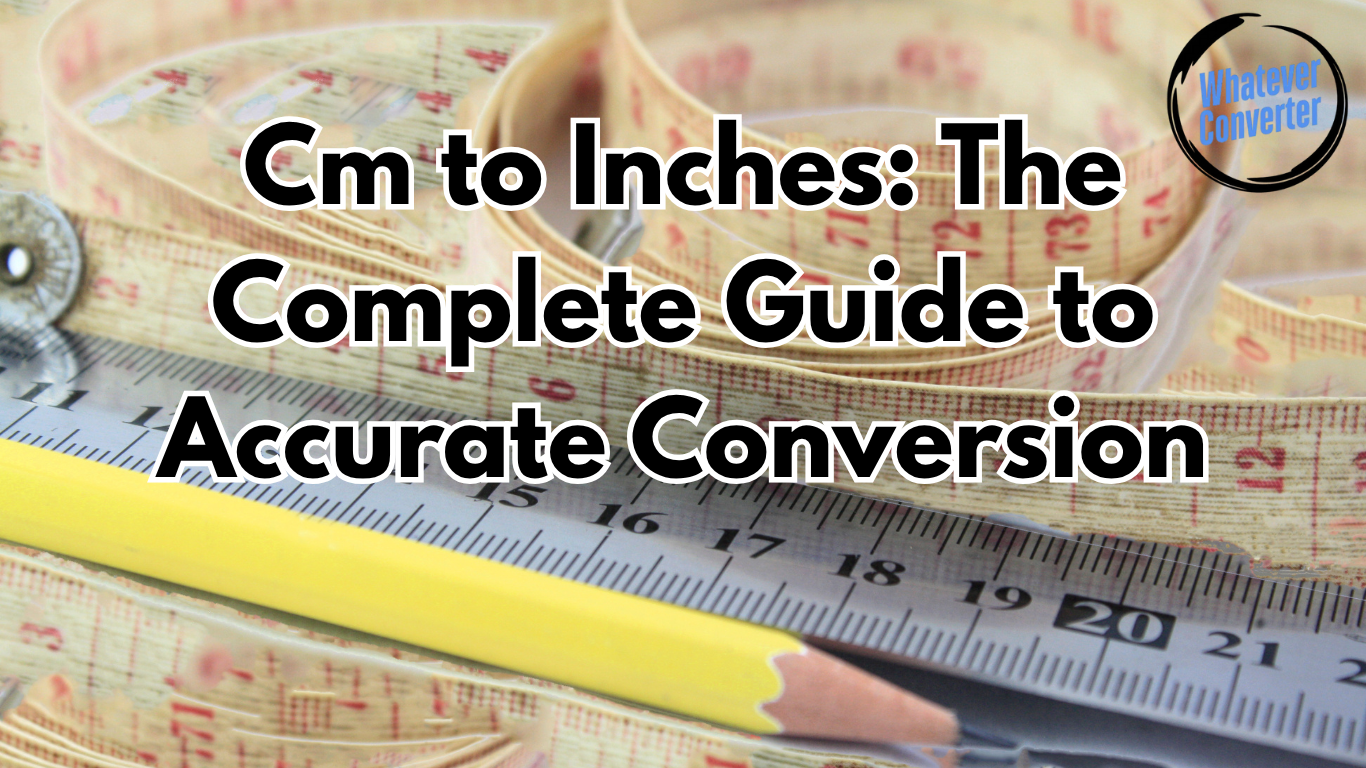Cm to Inches: The Complete Guide to Accurate Conversion

Strong 8k brings an ultra-HD IPTV experience to your living room and your pocket.
Understanding the Basics: What Are Centimeters and Inches?
Before diving into how to convert cm to inches, it's essential to understand what these two units represent.
Centimeters (cm) are a part of the metric system, a decimal-based system of measurement used in most parts of the world. One centimeter equals one-hundredth of a meter, making it a precise and straightforward unit for measuring smaller lengths, especially in scientific and everyday contexts across Europe, Asia, and Latin America.
On the other hand, inches belong to the imperial system, primarily used in the United States and a few other countries. One inch is defined as exactly 2.54 centimeters, a standardized measurement accepted worldwide since 1959.
Because these systems serve different regions and industries, converting between them has become a necessary skill for professionals, students, and casual users alike.
The Exact Conversion Formula: How to Convert Cm to Inches
The conversion formula is straightforward:
Inches = Centimeters ÷ 2.54
Alternatively, you can multiply:
Inches = Centimeters × 0.393701
Both approaches yield the same result. However, dividing by 2.54 is often considered more precise because 2.54 is the officially standardized value for one inch in centimeters.
Let’s take a practical example:
If you want to convert 50 cm to inches:
50 ÷ 2.54 = 19.685 inches
Or using multiplication:
50 × 0.393701 = 19.685 inches
Whether you're measuring a piece of furniture, garment dimensions, or packaging length, this formula ensures that your conversion is accurate and universally accepted.
Why Accurate Conversion Matters in Real Life
Accurate unit conversion is more than academic. It impacts several areas of daily life and work. Let’s explore a few situations where converting cm to inches is critical.
Online Shopping and Product Dimensions
When buying clothing, electronics, or home goods online—especially from international websites—you’ll often encounter sizes and dimensions listed in cm or inches. A pair of jeans with a 76 cm waist translates to approximately 29.92 inches, which most U.S. buyers would round to a 30-inch waist. Inaccurate conversions could lead to ordering the wrong size or product.
Construction and DIY Projects
Suppose you're following a woodworking tutorial from the U.S., but you're in a country that uses the metric system. The design might list a board length as 40 inches. If you’re using metric tools, you'll need to convert that to centimeters: 40 × 2.54 = 101.6 cm. This conversion ensures materials fit correctly and designs remain structurally sound.
Science and Education
In scientific research, precision is key. Misunderstanding or miscalculating a conversion can significantly affect results. Students often face the need to convert cm to inches while working with measurement tools, physics problems, or during international academic collaboration.
Quick Reference: Cm to Inches Conversion Chart
While formulas are useful, having a conversion chart on hand can save time, especially when working with frequently used values. Here’s a quick-reference table:
Centimeters (cm) Inches (in)
1 cm 0.3937 in
5 cm 1.9685 in
10 cm 3.937 in
25 cm 9.8425 in
50 cm 19.685 in
75 cm 29.5276 in
100 cm 39.3701 in
150 cm 59.0551 in
200 cm 78.7402 in
These values provide quick insights when you’re working on-the-go or doing comparisons. For even faster conversions, you can use online tools like WhateverConverter, which allows instant, accurate cm to inches conversion without manual calculations.
Common Mistakes and How to Avoid Them
Despite its simplicity, converting cm to inches can go wrong. Let’s break down the common errors and how to steer clear of them.
Rounding Too Early
If you round intermediate steps during calculation, especially in projects requiring high precision, your final results could be significantly off. It’s best to keep numbers in full until the last step, then round off if necessary.
Using Incorrect Conversion Factor
The most common mistake is using an imprecise or outdated conversion value. Always use 2.54 cm = 1 inch, which is the globally accepted standard.
Switching Units Mid-Task
Sometimes users start calculations in centimeters but switch to inches without maintaining consistency. Always double-check unit labels on graphs, blueprints, and instructions before proceeding.
Forgetting to Check Unit Systems
When working in mixed-unit environments (e.g., with imported tools or plans), it’s easy to misread a measurement. Double-confirm whether values are in cm or inches before converting.
These simple checks can save time, materials, and frustration.
Choosing the Right Conversion Method: Manual vs. Digital Tools
Depending on your needs, you can choose between manual calculation or using digital tools.
Manual Calculation
Ideal for those needing to understand the math behind the conversion. Engineers, students, and anyone working in technical fields may prefer this method for its transparency and control.
Digital Tools
If speed and convenience are your priorities, a digital cm to inches converter is the way to go. The WhateverConverter website offers an intuitive and accurate cm to inches converter with zero learning curve. You simply enter the centimeter value, and it provides the inch equivalent instantly.
You can also bookmark the tool for repeated use, especially if your work frequently involves switching between metric and imperial systems.
Final Thoughts: Mastering the Art of Cm to Inches Conversion
In a globalized environment, where metric and imperial units coexist across borders, understanding how to convert cm to inches is not just helpful—it’s essential. Whether you’re a student, a professional, or a curious learner, mastering this basic conversion opens doors to better comprehension, accurate planning, and smoother communication.
By remembering the conversion factor (1 inch = 2.54 cm) and using trusted resources like WhateverConverter, you can make quick, accurate calculations without second-guessing your results. Additionally, being aware of the common pitfalls and learning how to avoid them will keep your work error-free and reliable.
So next time you encounter a measurement in centimeters, you’ll know exactly how to convert it to inches confidently and correctly.
Note: IndiBlogHub features both user-submitted and editorial content. We do not verify third-party contributions. Read our Disclaimer and Privacy Policyfor details.







